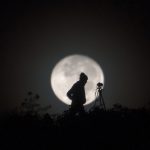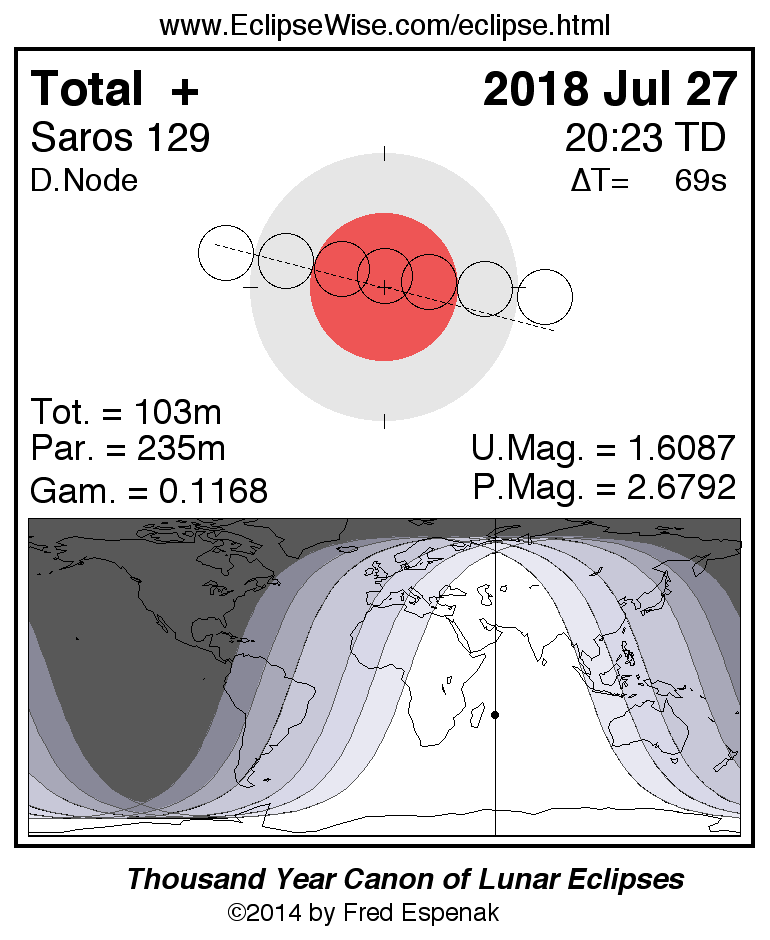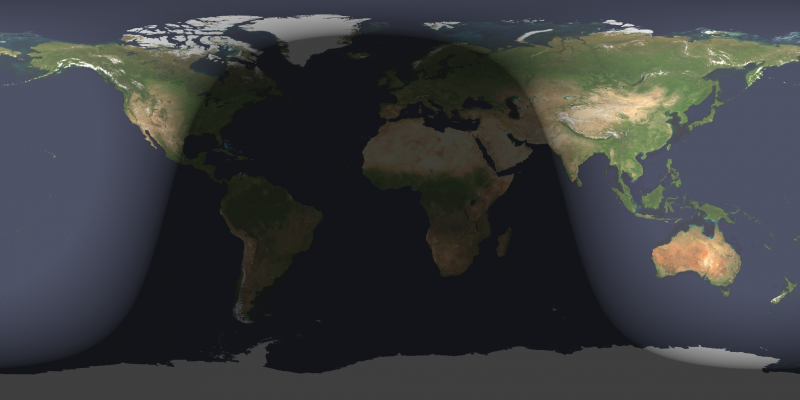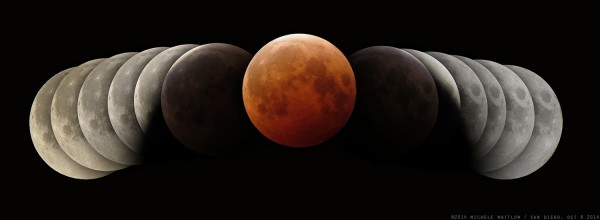
For general reference, we say a full moon is full all night. Because, in order to look full, the moon has to be more or less opposite the sun, every full moon rises in the east around sunset and climbs highest up for the night midway between sunset and sunrise (around midnight). Every full moon sets around sunup. That’s true as seen from around the globe.
But, technically speaking, the moon is full only at the instant that it’s 180o from the sun in ecliptic longitude. The moon turns full on April 30, 2018 at 00:58 UTC, which at North American time zones translates to April 29 at 9:58 p.m. ADT, 8:58 p.m. EDT, 7:58 p.m. CDT, 6:58 p.m. MDT and 5:58 p.m. PDT.
This full moon will be near a very bright planet, Jupiter, as shown on the chart below:
Here’s something else fun about this April 2018 full moon, and, in fact, about most full moons. That is, it won’t undergo an eclipse. In fact, the April 2018 full moon swings a whopping 5o (10 moon diameters) north of the ecliptic, the plane of Earth’s orbit around the sun. So it misses being in Earth’s shadow by a wide margin.
Some full moons come closer to passing through Earth’s shadow – that is, closer to being in eclipse without actually doing so – but the fact is that most full moons fail to reside at the antisolar point, the point that’s directly opposite the sun. It’s only when the moon passes through or very close to the antisolar point that we see a total eclipse of the moon.
The next two full moons – May and June 2018 – will pass to the north of the ecliptic and the antisolar point, too. So there will be no lunar eclipse in May or June 2018.
The July 2018 full moon will sweep right through the antisolar point. The center of the full moon will pass a scant one-tenth of a degree north of the ecliptic. So, if you’re on the right place on Earth, you’ll see a total lunar eclipse on July 27, 2018.
This total lunar eclipse on July 27 comes one fortnight (two weeks) after the partial solar eclipse of July 13, 2018, and one fortnight (two weeks) before the partial solar eclipse on August 11, 2018.
Read more: Why no eclipse at every full and new moon?

Worldwide map of the total eclipse of the moon via EclipseWise. Note that the full moon passes right over the antisolar point (the + at the center of the Earth’s shadow). Click here for a more detailed chart.
This April full moon is the second full moon after the March equinox. In North America, we’ll call it the Pink Moon, Grass Moon or Egg Moon. Meanwhile, in the Southern Hemisphere, this full moon is called the Hunter’s Moon, the full moon that immediately follows the Harvest Moon.
Read more: What are the full moon names?

Worldwide map via the US Naval Observatory, showing the daytime and nighttime sides of Earth at the instant of full moon (2018 April 30 at 00:58 UTC). The shadow line at left (running through the US) depicts sunset April 29, and the shadow line at right represents sunrise April 30.
Bottom line: From the world’s western hemisphere, the moon is full on the night of April 29, 2018. From the eastern hemisphere, it’s full on April 30. It swings a whopping 5o (10 moon diameters) north of the plane of Earth’s orbit around the sun and misses being in Earth’s shadow by a wide margin.
Four keys to understanding moon phases
Can you tell me the full moon names?
from EarthSky https://ift.tt/1iAoPbQ

For general reference, we say a full moon is full all night. Because, in order to look full, the moon has to be more or less opposite the sun, every full moon rises in the east around sunset and climbs highest up for the night midway between sunset and sunrise (around midnight). Every full moon sets around sunup. That’s true as seen from around the globe.
But, technically speaking, the moon is full only at the instant that it’s 180o from the sun in ecliptic longitude. The moon turns full on April 30, 2018 at 00:58 UTC, which at North American time zones translates to April 29 at 9:58 p.m. ADT, 8:58 p.m. EDT, 7:58 p.m. CDT, 6:58 p.m. MDT and 5:58 p.m. PDT.
This full moon will be near a very bright planet, Jupiter, as shown on the chart below:
Here’s something else fun about this April 2018 full moon, and, in fact, about most full moons. That is, it won’t undergo an eclipse. In fact, the April 2018 full moon swings a whopping 5o (10 moon diameters) north of the ecliptic, the plane of Earth’s orbit around the sun. So it misses being in Earth’s shadow by a wide margin.
Some full moons come closer to passing through Earth’s shadow – that is, closer to being in eclipse without actually doing so – but the fact is that most full moons fail to reside at the antisolar point, the point that’s directly opposite the sun. It’s only when the moon passes through or very close to the antisolar point that we see a total eclipse of the moon.
The next two full moons – May and June 2018 – will pass to the north of the ecliptic and the antisolar point, too. So there will be no lunar eclipse in May or June 2018.
The July 2018 full moon will sweep right through the antisolar point. The center of the full moon will pass a scant one-tenth of a degree north of the ecliptic. So, if you’re on the right place on Earth, you’ll see a total lunar eclipse on July 27, 2018.
This total lunar eclipse on July 27 comes one fortnight (two weeks) after the partial solar eclipse of July 13, 2018, and one fortnight (two weeks) before the partial solar eclipse on August 11, 2018.
Read more: Why no eclipse at every full and new moon?

Worldwide map of the total eclipse of the moon via EclipseWise. Note that the full moon passes right over the antisolar point (the + at the center of the Earth’s shadow). Click here for a more detailed chart.
This April full moon is the second full moon after the March equinox. In North America, we’ll call it the Pink Moon, Grass Moon or Egg Moon. Meanwhile, in the Southern Hemisphere, this full moon is called the Hunter’s Moon, the full moon that immediately follows the Harvest Moon.
Read more: What are the full moon names?

Worldwide map via the US Naval Observatory, showing the daytime and nighttime sides of Earth at the instant of full moon (2018 April 30 at 00:58 UTC). The shadow line at left (running through the US) depicts sunset April 29, and the shadow line at right represents sunrise April 30.
Bottom line: From the world’s western hemisphere, the moon is full on the night of April 29, 2018. From the eastern hemisphere, it’s full on April 30. It swings a whopping 5o (10 moon diameters) north of the plane of Earth’s orbit around the sun and misses being in Earth’s shadow by a wide margin.
Four keys to understanding moon phases
Can you tell me the full moon names?
from EarthSky https://ift.tt/1iAoPbQ




Aucun commentaire:
Enregistrer un commentaire